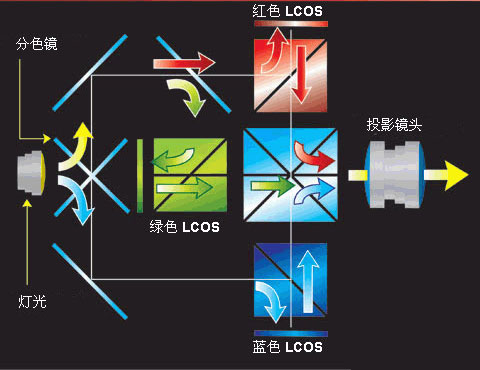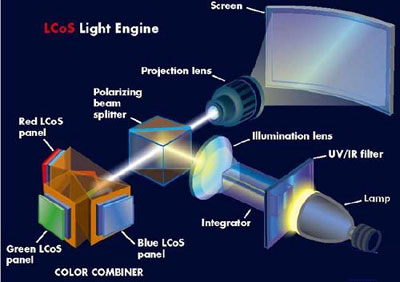Introduction of LCoS micro devices, LCOS optical engine architecture
The LCoS microdevice puts the liquid crystal layer between a transparent thin-film transistor (TFT) and a silicon semiconductor, instead of putting liquid crystal between two polarized panels like an LCD. This semiconductor has a distorted surface that reflects light. The light emitted by the bulb is projected onto the micro-device through a polarizing filter, and the liquid crystal acts like a door or valve to control the amount of light reaching the reflecting surface. The higher the voltage received by the crystal of a particular pixel, the more light the crystal allows to pass through. Several layers of different materials are required to complete the entire process.

The components and functions of LCoS micro-devices are described below from bottom to top:
Printed circuit board (PCB): transmits commands and current from the TV to the micro device silicon (chip or sensor): uses data from the TV pixel driver to control the liquid crystal, usually using a transistor reflective coating for each pixel: Reflect the light to produce the picture liquid crystal: control the amount of light reaching or leaving the reflective coating. Alignment layer: enable the liquid crystal to be properly aligned, so as to accurately calibrate the light. Transparent electrode: together with silicon and liquid crystal to form a complete circuit cover Protect and seal the entire systemThe exact materials and construction vary by manufacturer. Some micro devices use nematic liquid crystal, while others use ferroelectric liquid crystal. Some use organic alignment layers, and they will decompose with extended use time and high intensity exposure. Some use photosensitive materials and light to control the pulse to the liquid crystal.

The orientation of the crystal relative to the reflective surface will change under the action of current. Most are almost orthogonal to the reflective surface when the current is off, and obliquely cross it when the current is on.
In general, there are only very small gaps between pixels in LCoS devices. The pixel pitch-the horizontal distance between two pixels of the same color-is 8 to 20 microns (10-6). This can reduce or eliminate the "screen door" effect that appears on some DLP TV sets, thereby helping to keep the image smooth and uniform.
LCOS optical engine architectureLCOS optical engine architecture can be roughly divided into two types, three-piece optical engine and single-chip optical engine.
1. Three-piece optical engineThe LCOS optical engine is currently dominated by a three-piece type. The three-piece type divides the light source into red, blue, and green light through a beam splitter prism, and then separately projects the light beam into three LCOS panels to project the three-color image. After the optical system converges and combines to form a color image. In addition to the three-piece LCOS optical engine, in addition to the three panels, combined with multiple splitting and combining systems, the volume is larger and the cost is higher. However, due to the high optical efficiency and high image quality The characteristics of it are mainly for the development of high-end professional uses such as large screens.
The following figure is the principle diagram of LCOS optical machine:

lamp: light bulb. M: miro reflection mirror.
DM: Dichroic Mirror (dichroic mirror) [daI`krEJIk] (Function: split light into red, green and blue). Integrated lens: Parabolic reflective lens (function: filter ultraviolet light and infrared light).
PS converter: Polarized light converter (Function: Use focusing lens and fly eye lens to get uniform parallel light
PBS: Polarized Beam Splitter (PolarizaTIon Beam Spliter; PBS) (Function: get the required light, the light is divided into P light and S light, PBS lets P light pass, and S light reflects)
RLCD (R): Reflective LCOS chip. ProjecTIon lens: imaging lens.
As shown in the above figure is the LCOS projection structure system, using UHP (cold light source lamp) as the light source, using parabolic reflectors to filter ultraviolet light and infrared light, and then using cold reflectors to filter infrared light, through the focusing lens and the compound eye lens to obtain uniform parallel The light is then split by a dichroic mirror, and then polarized light is obtained through PBS, synthesized by reflection from the LCOS chip, and projected onto the screen through a zoom lens to form an image.
The process of displaying signals by optomechanics: Connect the display and signals (including video signals, computer signals, etc.) to the LCOS optomechanical motherboard through a cable. The motherboard converts the signals into electronic signals, and then adds the electronic signals to the LCOS chip. On the drive board, the signal is converted into a digital signal by the board, and the digital signal is added to the LCOS chip through the LCOS drive board, and the signal is added to the optical machine beam by the LCOS chip, and the image is formed by the PBS, the light combining system and the imaging lens Projected on the screen, that is, the image we see.
The main structure of the LCOS projector and the LCD projector are similar in the design of the light guide and the beam splitting part, but in the LCOS projector system, more PBS is added in front of the LCOS panel.
The light emitted by the light source is divided into R, G and B three-color light after passing through the Dichroic Mirror (two-color mirror). After passing through the respective PBS, the three-color light will reflect S polarized light into the LCOS panel. The polarized light will be changed to P polarized light, and finally the three polarized lights combined with dichroic prism (Dichroic Prism) will be projected onto the screen to obtain the image.
Simply put, LCOS is directly related to CRT projection technology, high-temperature poly-silicon liquid crystal (Poly-Si LCD) transmission projection technology, DMD (Digital Micromirror Device) data optical processing (DLP; Digital Light Processing) reflective technology . These three technologies have matured, so LCOS can become the new mainstream of projection display technology.
2. Single-chip optical engineThe single-chip Color Wheel optical engine uses the fast-rotating ColorSwitch to form white light into sequential red, blue, and green lights. The three primary colors and the red, blue, and green screens generated by the driver are synchronized to form a color-separated image. Due to the persistence of the human eye's vision, a colorful projection screen is finally produced in the human brain.
The biggest advantage of the monolithic type is that because the number of panels is only one, and the system architecture of splitting and combining light is relatively simple, it is more competitive in cost and the space of the optical engine is relatively small. However, at present, there are some technical difficulties. In terms of Color Wheel, the polarized white light source is only 1/3 of the previous one, and the brightness is significantly reduced. In addition, because the LCOS panel has to be fast in red, blue and green pictures The composite image is switched, so the response speed of the panel is more demanding, which makes the difficulty of production increase.
Features of LCOS projection technologyCompared with LCD and DLP projector technologies, LCOS projection technology has the potential for high resolution, high brightness, and low cost. It is the star of tomorrow in projection technology.
1. High resolution and high definitionThe biggest feature of LCOS projection technology is that the lower substrate of the panel uses a silicon wafer CMOS substrate. Because the material of the lower substrate is single crystal silicon, it has good electron mobility, and single crystal silicon can form thinner circuits, so it is easier Produce high-resolution panels that display high-definition picture quality.
2. High brightnessLCOS is a reflective technology, unlike LCD optical engines, which will greatly reduce the light utilization rate due to light penetrating the panel, so the light utilization rate can be increased to 80%, which can be reduced compared to 3% for transmissive LCD Power consumption and can produce higher brightness.
3. Bright and full colorsThe development characteristics of the LCOS reflective liquid crystal display range in color is far higher than the three-shot (CRT) projector and other display technologies, and will almost be close to the NTSC color reproduction standard. Therefore, the high color saturation of the overall picture can be presented, so that the colors are colorful and full.
There are three LCOS chips in the optical machine, each of which has about 1.5 million pixels, and three of them are synchronized to form R, G, and B monochrome images. RGB three-color images are combined into a 24-bit (16777216-color) true color image by optical components, and then enlarged to the screen by a high-resolution wide-angle lens. The display of LCOS silicon crystal TV is more accurate and realistic, and the ultra-high brightness makes the picture performance even better.
4. Low costThe LCOS optical engine has the advantage of low cost because of the simple parts of the product. Coupled with the large investment of domestic manufacturers, compared with the LCD panel supplied by Epson, Sony, and the DLP panel exclusively supplied by TI, LCOS has The trend of rapid cost reduction.
LCOS projector adopts full digital signal processing technology, uses LCOS chip (liquid crystal on silicon) as reflection imaging device, uses digital light processing technology to modulate computer and video signals, and drives LCOS chip reflection imaging device system, which is obtained by combining light system and projection lens Large screen image. This technology has the characteristics of full image display color, high definition and high resolution of the picture, high brightness, high stability and maintenance-free. At present, a single LCOS projector can be widely compatible with multiple resolution signals. Multiple combined splicing can achieve ultra-high resolution display. The overall wall resolution is the superposition of the resolution of each projection display unit.
Power Skiving,Skived Heatsink,Aluminum Heat Sink,Skived Fin Heat Sink
Dongguan Formal Precision Metal Parts Co,. Ltd , https://www.formalmetal.com